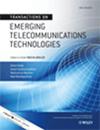T. Zahariadis, H. Leligou, P. Trakadas, S. Voliotis
{"title":"无线传感器网络中的信任管理","authors":"T. Zahariadis, H. Leligou, P. Trakadas, S. Voliotis","doi":"10.1002/ett.1413","DOIUrl":null,"url":null,"abstract":"SUMMARY The range of applications of wireless sensor networks is so wide that it tends to invade our every day life. In the future, a sensor network will survey our health, our home, the roads we follow, the office or the industry we work in or even the aircrafts we use, in an attempt to enhance our safety. However, the wireless sensor networks themselves are prone to security attacks. The list of security attacks, although already very long, continues to augment impeding the expansion of these networks. The trust management schemes consist of a powerful tool for the detection of unexpected node behaviours (either faulty or malicious). Once misbehaving nodes are detected, their neighbours can use this information to avoid cooperating with them, either for data forwarding, data aggregation or any other cooperative function. A variety of trust models which follow different directions regarding the distribution of measurement functionality, the monitored behaviours and the way measurements are used to calculate/define the node’s trustworthiness has been presented in the literature. In this paper, we survey trust models in an attempt to explore the interplay among the implementation requirements, the resource consumption and the achieved security. Our goal is to draw guidelines for the design of deployable trust model designs with respect to the available node and network capabilities and application peculiarities. Copyright © 2010 John Wiley & Sons, Ltd.","PeriodicalId":50473,"journal":{"name":"European Transactions on Telecommunications","volume":"49 1","pages":"386-395"},"PeriodicalIF":0.0000,"publicationDate":"2010-06-01","publicationTypes":"Journal Article","fieldsOfStudy":null,"isOpenAccess":false,"openAccessPdf":"","citationCount":"114","resultStr":"{\"title\":\"Mobile Networks Trust management in wireless sensor networks\",\"authors\":\"T. Zahariadis, H. Leligou, P. Trakadas, S. Voliotis\",\"doi\":\"10.1002/ett.1413\",\"DOIUrl\":null,\"url\":null,\"abstract\":\"SUMMARY The range of applications of wireless sensor networks is so wide that it tends to invade our every day life. In the future, a sensor network will survey our health, our home, the roads we follow, the office or the industry we work in or even the aircrafts we use, in an attempt to enhance our safety. However, the wireless sensor networks themselves are prone to security attacks. The list of security attacks, although already very long, continues to augment impeding the expansion of these networks. The trust management schemes consist of a powerful tool for the detection of unexpected node behaviours (either faulty or malicious). Once misbehaving nodes are detected, their neighbours can use this information to avoid cooperating with them, either for data forwarding, data aggregation or any other cooperative function. A variety of trust models which follow different directions regarding the distribution of measurement functionality, the monitored behaviours and the way measurements are used to calculate/define the node’s trustworthiness has been presented in the literature. In this paper, we survey trust models in an attempt to explore the interplay among the implementation requirements, the resource consumption and the achieved security. Our goal is to draw guidelines for the design of deployable trust model designs with respect to the available node and network capabilities and application peculiarities. Copyright © 2010 John Wiley & Sons, Ltd.\",\"PeriodicalId\":50473,\"journal\":{\"name\":\"European Transactions on Telecommunications\",\"volume\":\"49 1\",\"pages\":\"386-395\"},\"PeriodicalIF\":0.0000,\"publicationDate\":\"2010-06-01\",\"publicationTypes\":\"Journal Article\",\"fieldsOfStudy\":null,\"isOpenAccess\":false,\"openAccessPdf\":\"\",\"citationCount\":\"114\",\"resultStr\":null,\"platform\":\"Semanticscholar\",\"paperid\":null,\"PeriodicalName\":\"European Transactions on Telecommunications\",\"FirstCategoryId\":\"1085\",\"ListUrlMain\":\"https://doi.org/10.1002/ett.1413\",\"RegionNum\":0,\"RegionCategory\":null,\"ArticlePicture\":[],\"TitleCN\":null,\"AbstractTextCN\":null,\"PMCID\":null,\"EPubDate\":\"\",\"PubModel\":\"\",\"JCR\":\"\",\"JCRName\":\"\",\"Score\":null,\"Total\":0}","platform":"Semanticscholar","paperid":null,"PeriodicalName":"European Transactions on Telecommunications","FirstCategoryId":"1085","ListUrlMain":"https://doi.org/10.1002/ett.1413","RegionNum":0,"RegionCategory":null,"ArticlePicture":[],"TitleCN":null,"AbstractTextCN":null,"PMCID":null,"EPubDate":"","PubModel":"","JCR":"","JCRName":"","Score":null,"Total":0}
引用次数: 114
Mobile Networks Trust management in wireless sensor networks
SUMMARY The range of applications of wireless sensor networks is so wide that it tends to invade our every day life. In the future, a sensor network will survey our health, our home, the roads we follow, the office or the industry we work in or even the aircrafts we use, in an attempt to enhance our safety. However, the wireless sensor networks themselves are prone to security attacks. The list of security attacks, although already very long, continues to augment impeding the expansion of these networks. The trust management schemes consist of a powerful tool for the detection of unexpected node behaviours (either faulty or malicious). Once misbehaving nodes are detected, their neighbours can use this information to avoid cooperating with them, either for data forwarding, data aggregation or any other cooperative function. A variety of trust models which follow different directions regarding the distribution of measurement functionality, the monitored behaviours and the way measurements are used to calculate/define the node’s trustworthiness has been presented in the literature. In this paper, we survey trust models in an attempt to explore the interplay among the implementation requirements, the resource consumption and the achieved security. Our goal is to draw guidelines for the design of deployable trust model designs with respect to the available node and network capabilities and application peculiarities. Copyright © 2010 John Wiley & Sons, Ltd.

 求助内容:
求助内容: 应助结果提醒方式:
应助结果提醒方式:


